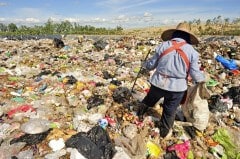The researcher also examined how dioxins found in coal ash originating from burned waste are affected by different cooling and heating treatments, in order to find possible methods for purifying the ash

[Translation by Dr. Moshe Nachmani]
Dioxins are formed more rapidly, at lower temperatures and under conditions unknown until now. This result may affect the way in which the sampling equipment for locating these substances is built in the future, the filtration systems for the gas stream in waste incinerators and the way coal ash obtained from waste incineration is handled.
Dioxins are formed more rapidly, at lower temperatures and under conditions unknown until now. This result may affect the way in which the sampling equipment for locating these substances is built in the future, the filtration systems for the gas stream in waste incinerators and the way coal ash obtained from waste incineration is handled. These are some of the conclusions of the doctoral thesis of the researcher Eva Weidemann from Umeå University in Sweden.
Dioxins (Dioxins, Wikipedia) is the common name for a defined group of chlorinated organic molecules, some of which exhibit hormone-disrupting capabilities and have carcinogenic properties. Dioxins may form during the burning of waste, as the gas cools. "When you burn waste, the formation of a certain amount of dioxin is inevitable, but thanks to modern chimney gas purification systems, the amount of emissions coming out of the chimneys is reduced. The dioxins are filtered from the exhaust gases and eventually end up in the coal ash," explains the researcher.
The formation of dioxins has been known since the XNUMXs, but in her research, the scientist shows that these toxic substances may also be formed under conditions not previously observed. Among her other findings, she shows the formation of dioxins in the filters of the exhaust gases in the waste incineration plant. "The purpose of the filters is to keep the dioxins away from the exhaust gases, but I found that instead they actually form there. Admittedly, the amount of dioxin emissions emitted by the factory is lower than the legal threshold, but the very formation of this toxic substance is bad news. We located several parameters responsible for the formation of the material and several possible mechanisms. My hope is that our results can contribute to the development of more efficient filters," explains the lead researcher.
Another problem that the researcher referred to in her research work is that dioxins may form inside the sampling equipment used during sampling at high temperatures. The researcher's solution is to use more efficient cooling during the critical stages, which will prevent the formation of dioxins.
The researcher also examined how dioxins found in coal ash originating from burned waste are affected by different cooling and heating treatments, in order to find possible methods for purifying the ash. Although the results are not yet final, they provide the pieces of the assembly that can help researchers in the future. "If we can find an effective method for purifying the coal ash, it will be an environmental benefit in terms of dioxin and also in other respects such as recycling," explains the researcher.
Despite the presence of dioxins, burning waste is a good option for utilizing the energy stored in waste that cannot be stored or recycled. In this process, the weight and volume of the waste are reduced while removing bacteria and unpleasant odors. In addition, burning is a more environmentally friendly method compared to waste landfills. The methane gas produced during combustion is a less harmful greenhouse gas than the carbon dioxide gas produced in other processes. The problem of pollution that was found in the 80s and 90s is almost non-existent today, thanks to advanced filters and more efficient purification systems, along with a routine audit of the emissions.
